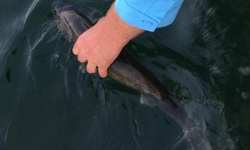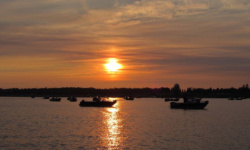As we wrap up autumn and winter ice fishing looms, don’t forget to re-consider another angling option during the cold-weather months: open-water fishing.
No joke, folks. In the majority of the country, soft-water angling opportunities exist year-round. Even in my cold home state of Minnesota, I’m rarely more than a day’s drive from some river fishing during the coldest days of January. A month or two either side of January, and that becomes a half-day’s drive, a couple hours, or even less.
Your boat and equipment can handle fishing in remarkably cold weather. Give me flat or light winds, and I’ve had great days on the water – especially on rivers – when the temperature barely has topped 20 degrees.
So can you use your boat during these shorter days of late autumn and winter? Without question – if you use common sense. Here are a few tips to consider in that regard:
For starters, as soon as you remove your boat from the water, drop your outboard and kicker and let them drain.
I’ll even hit the key a couple of times just to release any water in the motor itself. Emphasis here: Do not start the motor. You’ll ruin it. Just switch the key fast – on-off, on-off.
If you used your trolling motor, drop it down, too, and let it drain.
You’re probably removing that drain plug anyway to avoid transporting aquatic invasive species, but whenever you are in a cold fishing situation, pull that drain plug. Water expands when it freezes, so if you leave it undrained, that ice can damage your boat.
Now, remove all water from the bilge pump. Also make sure that livewell is drained, and after draining, wipe it out with a towel, especially in the drain area.
Helpful winter hint: To avoid worrying about the livewell, simply take an old cooler with some water and throw the fish in there. They’ll stay plenty cold.
Be careful of ice at the landing when launching or removing your boat. And especially on a bunk trailer, be aware that when you back in and unload, the bunks almost automatically freeze up.
That’s very important to remember when loading back up and when you drive the boat on. Be doubly sure to hook that winch strip, and tie it off. Otherwise, with all that ice, it will slide right off that ice trailer … and bam!
Follow the same procedure when you unload. Keep that winchstrap on!
Also be careful and watch that the boat hasn’t frozen onto the bunks. If it has, simply rock it back and forth to loosen.
Keeping your boat in a heated garage helps any excess water drain and evaporate, but if you follow the guidelines I’ve provided here, you can keep your boat in an unheated – albeit covered – area, too.
If it’s so cold that your rods and reels are freezing up, you probably don’t want to search for open water, but when I can find 20 to 30 degrees and a free-flowing river, a day on the water is pretty awesome, even in winter.

![Keeping the boat primed for river fishing and other soft-water, winter angling opportunities [video]](https://jrproteam.com/wp-content/uploads/2017/11/TerryTumaWinterBoating.jpg)




